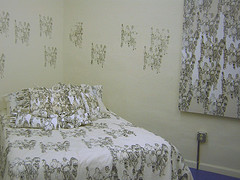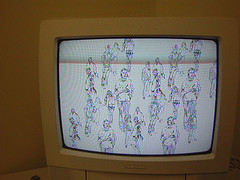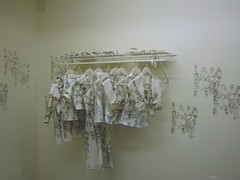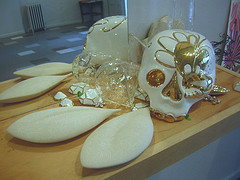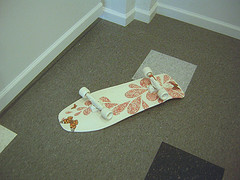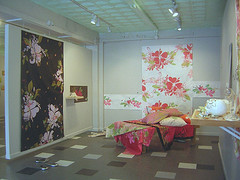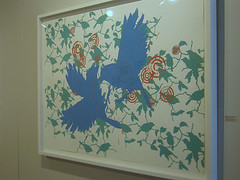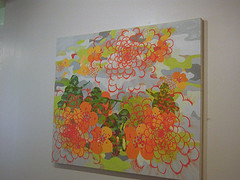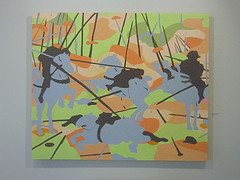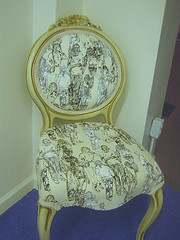
My post-Chelsea droop factor got fixed right here in Philadelphia at Falling Cow Gallery. Embellish, the exhibit there, is an exuberant take on decoration as fine art and fine art as decoration, with work from three women, two familiar, one not. The artists are New Yorker Sara Gates and Philadelphians Candy Depew and Jackie Hoving.
Best of all, the work–an installation by Depew, an installation by Gates, and a group of paintings and prints by Hoving–is about more than decoration.
Sara Gates
Gates created a bedroom with screen prints of one image printed multiple times on chair fabric, on pillows and bedding, on a video, on paintings and even on clothing. The image is of a bunch of young women approaching and looking festive. I don’t know if they are walking toward the camera or standing around talking at a party. But they have become outlines (I presume we can credit the coloring-book option in Photoshop), and they project the energy of sexy, happy youth.
This same image looks like toile on a chair and on pillows, like a more random print on a bedspread, like a complex painting element on stretched canvas and like a hip wall mural circling the room at eye level. It also lends an arty patterning to some clothing also made by the artist, and it hops up and down on a looping video being played on the girl’s-room obligatory television.
The installation is utterly believable, a peaceful, ruffly space with homey touches. The choice of subject matter and the method of its creation as an outline drawing, while it might refer to the courtly ladies and gentlemen outlined in traditional toile fabrics, puts us squarely in the 21st Century, as does the television and DVD. Unpredictable applications of white paint add irregular rhythm and sizzle to the patterns. The repetitions refer to more than the repetitions in fabric-making. They raise questions about uniqueness in art–as they raise questions about the uniqueness of the individuals who fit in a generation or social group.
Furthermore, the gallery list of works for the show states the artist can make clothing, accessories or furniture on request. The canvases are not available as multiples, and their prices reflect their art-world uniqueness (from $600 to $2,200). Some of the household goods and clothes, are more affordable, however.
Candy Depew
I don’t know that I would have been taken as I was with Candy Depew’s high-color installation of fabrics and ceramics had I not walked through Bergdorf Goodman with Roberta and her sister Cate when we were in New York the day before. On our way to the ladies’, we were beset by a floor flashing with mirrors, shiny glass cases, the tinkling of the hard surfaces plus lots and lots of makeup –a whole floor of makeup! In that context, Depew’s two shelves of decorative bone-china skulls, blown glass objects and mirrors suddenly reflected vain attempts to overcome the flaws and signs of time marching on–ultimately death.
Depew’s cast vitreous china skateboards took me somewhere not so dissimilar–the vulnerability of the material reflecting the vulnerability of our bodies (is it me or the art?). One skateboard was covered with monarch butterflies, the other with what looked like a rained-on window and a superhero sticker–all talking to the evanescent beauty of youth.
This turn to some kind of content beyond decoration is fairly recent in Depew’s work, and in my view finally gives it some of the heft that her visual facility and creativity deserve.
Depew’s installation is filled with the beautiful colors of fabrics she printed, which hang, drape and cover pillows. She also printed giant stickers with some of the same prints. The installation overall is a take on an upscale commercial showcase and it’s in the details that gravitas resides.
Jackie Hoving
Hoving also makes use of screen-printing techniques and fabric patterns as well as painting that has the same flat kind of shape-making that screen-printing provides. Hoving plows the subject/ground push and pull, embedding acts of violence in pretty-pretty patterns. I had previously seen her work on animals in hunters’ sights, but this new work also includes military operations–tanks and soldiers. The soldiers are camouflage patterns amidst floral explosions and camouflage clouds of smoke.
Moving the subject matter from the violence of hunting animals–an activity that is not beyond the pale of all moral systems–to hunting humans–an activity deplored by one and all–at a time of war seems just right.
Hoving’s use of highly decorative colors and patterns that suggest wallpaper and fabric in formal, upperclass settings, matches the ways we distance ourselves from the painful horrors of the world around us. Decoration is always, in some way, a way to make things better, and the more horrible, the more we need to decorate and distance ourselves. Of course the war in Iraq is another distraction or decoration for the front page, to take our minds and eyes off the war in our cities, in our own backyard. They shoot children, don’t they? (Oh, well, when I see the pictures of the young men killed in the war, I also feel like they too are our children.)
Embellish is the second multi-artist exhibit this year on the subject of pattern and decoration (see post here), and it’s one any number, like Alex Da Corte’s show now at Space 1026 (see Roberta’s post here) or Xiang Yang’s (see post) and Elisheva Biernoff and Jennifer Smith’s contributions to the OUTside/IN exhibit at the Art Alliance (for images, go here and here on Flickr). That’s to name just a few of the artists mining this territory. While the subject is always a stream in the mainstream, maybe Hoving got it right. We’re desperate for distraction.
Curated by Falling Cow Co-Director Sarah Eberle (formerly store manager at the Print Center), the exhibit is the gallery’s third show, but the first one not featuring the work of gallery owner Tim Bowen, and it promises well for both Eberle and the gallery.


